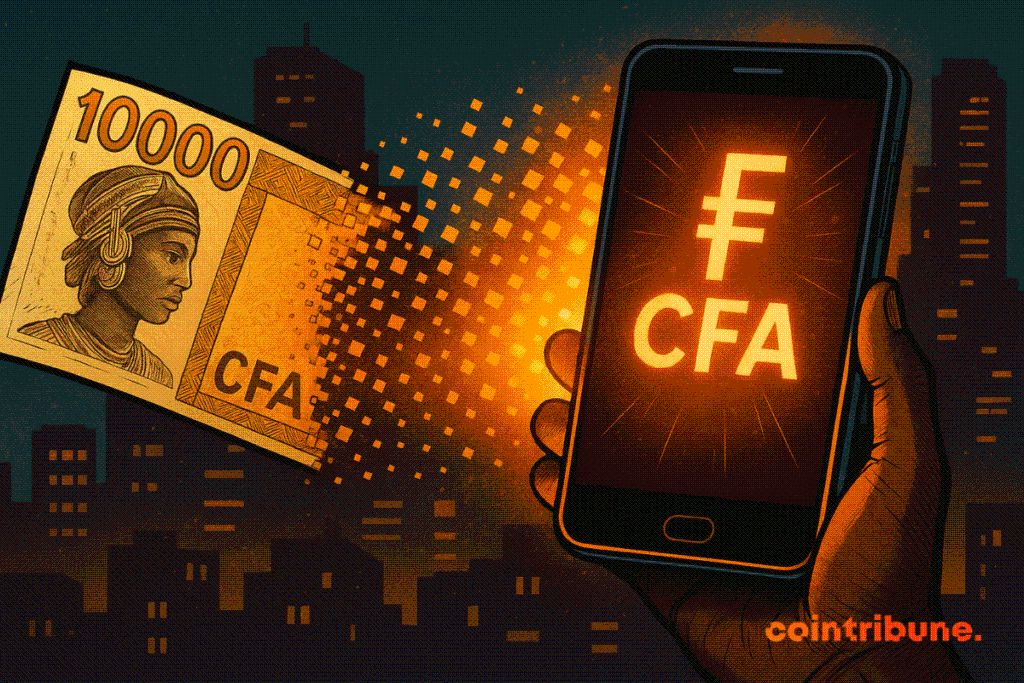The BCEAO will launch the e-CFA: A digital version of the CFA franc for 8 countries
While several major economic powers still hesitate to adopt a central bank digital currency, West Africa is accelerating. Eight member countries of the UEMOA are about to take a step forward with the e-CFA. A technological revolution with geopolitical reach? In a region where the CFA franc crystallizes debates on the colonial legacy, this digital turn could well be the first step towards a reinvented monetary independence.

In brief
- The e-CFA will be pegged to the CFA franc, with equivalence guaranteed by the BCEAO.
- It promises fast payments, accessible even without a bank account or stable internet connection.
- Regional fintechs will have to adapt or disappear according to the evolution of the programmable model of the e-CFA.
- The project fuels the debate over monetary sovereignty within a framework still linked to the euro.
e-CFA vs cryptos: a technological duel… but not on equal footing
The BCEAO presents the e-CFA as a strategic response to the expansion of fintechs and the rise of crypto. Orange Money, Wave, or even Binance (and other platforms to buy bitcoin) already attract millions of users on the continent. To keep control, the Central Bank strikes back with its own solution: official, regulated, interoperable.
The e-CFA will be usable by card, phone, or mobile app, even offline. Objective: to also reach the unbanked, who are the majority in the region. This is a true repositioning of the institution, which seeks to regain its centrality in everyday transactions. The e-CFA promises speed, security, and inclusion. But it retains one particularity: it remains pegged to the euro. This raises strong criticism.
In an op-ed published in August 2025 , economist Adama Wade already pointed out the paradox of the e-CFA: it does not break with the inherited system, it simply digitizes its mechanisms. It modernizes dependence without offering real emancipation.
Against it, cryptocurrencies offer freedom but lack stability. The duel continues.
When bills become ghosts: revolution in our pockets
No more coins. No more bills. The e-CFA signals the progressive disappearance of paper money. This is a small revolution in markets, taxis, or neighborhood shops. Currency moves to all digital, and everyone is concerned.
But criticisms exist. Some voices point out the risks of increased control over transactions. Others fear increased state surveillance. Not to mention that the e-CFA is programmable: in theory, its use could be limited to certain expenses or durations.
In this mutation, West Africa must juggle between innovation and the preservation of individual freedoms. Crypto, even unstable, continues to attract those who want to flee centralized models.
Digital inclusion or social divide: the big test of the e-CFA
One of the flagship arguments for the e-CFA is financial inclusion. But how to include without excluding? In some rural areas, access to electricity remains uncertain. Not to mention digital illiteracy affecting a large part of the population.
To succeed, the BCEAO will have to go beyond simple technical innovation. Financial education campaigns, local partnerships, applications accessible to the most vulnerable will be essential. Otherwise, this digital currency will remain an urban luxury.
Dr. Mohamed H’Midouche warns of a very real risk: if the digital divide is not anticipated, the financial inclusion promised by the e-CFA could paradoxically turn into exclusion for the most vulnerable populations.
e-CFA: the key figures to understand
- 24%: average banking rate in UEMOA in 2023;
- 52%: population with access to financial services through mobile money;
- September 30, 2025: official launch of the PISPI platform for instant payments;
- 6%: banking rate in Niger, one of the lowest in the region;
- 90%: share of digital transactions managed by M-Pesa in Kenya (outside UEMOA).
The e-CFA opens a new era. But it’s just a beginning. Africa becomes a monetary laboratory where everything is experimented: from local stablecoin to Telegram’s ambitions, which already sees itself as the key to crypto boom on the continent . The next battle will not be fought in banks, but in the connected pockets of its citizens.
Disclaimer: The content of this article solely reflects the author's opinion and does not represent the platform in any capacity. This article is not intended to serve as a reference for making investment decisions.
You may also like
Ethereum News Update: Avail’s Nexus Bridges Liquidity Across 12 Blockchains, Tackling Fragmentation
- Avail's Nexus Mainnet launches as a cross-chain execution layer unifying liquidity across 12 blockchains including Ethereum and BNB Chain. - The intent-solver architecture automates optimal routing while aggregating liquidity from multiple chains through Avail's data availability layer. - Developers gain simplified cross-chain integration via SDKs and APIs, enabling real-time collateral pools and intent-based trading without managing bridges. - With Solana integration planned and Infinity Blocks roadmap

Ethereum News Update: Ethereum Drives Institutional Transformation with Amundi Tokenizing Major Fund
- Amundi tokenizes a money market fund on Ethereum , signaling institutional adoption of blockchain-based asset management. - Ethereum's upgrades like PeerDAS and Bhutan's $970k ETH staking highlight growing institutional trust in its infrastructure. - CoinShares' $250M Bitcoin Miners ETF and global digital ID initiatives underscore tokenization's role in modernizing finance. - Ethereum's $3,100 price resistance and technical indicators suggest potential for long-term resilience amid scaling improvements.

Hyperliquid News Today: Hyperliquid Adopts Tidewater’s Strategy to Streamline Crypto Risk Management
- Hyperliquid introduces automated downsizing to stabilize HYPE, which dropped 52% from its peak. - Strategy mirrors Tidewater Renewables' capacity management, balancing short-term volatility with long-term stability. - Hyperliquid Strategies DAT plans $300M HYPE buybacks to inject liquidity and institutional-grade risk frameworks. - Market faces $1.89B+ liquidation risks if Bitcoin/Ethereum surge, prompting automated buffers to prevent cascading sell-offs. - Approach reflects growing DeFi adoption of algo
The Unexpected COAI Price Decline: Key Lessons for Investors from the November 2025 Market Turbulence
- COAI Index's 88% November 2025 collapse stemmed from C3.ai governance failures, regulatory ambiguity, and panic-driven herd behavior. - Market psychology amplified losses as investors overreacted to AI sector risks, ignoring fundamentals and triggering liquidity crises. - Diversification, cash reserves, and AI-driven tools helped mitigate risks, emphasizing long-term strategies over speculative hype. - The crisis exposed dangers of overreliance on AI/DeFi narratives, urging disciplined, diversified portf

